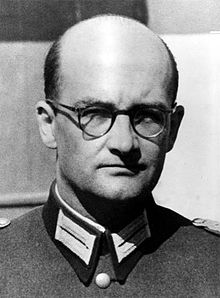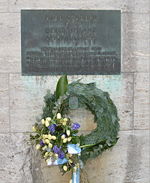Albrecht Mertz von Quirnheim: Difference between revisions
Added categories |
|||
| (17 intermediate revisions by 11 users not shown) | |||
| Line 3: | Line 3: | ||
<!--Please don't delete the following picture of Quirnheim without discussion on this article and the image's talk page; thank you!--> |
<!--Please don't delete the following picture of Quirnheim without discussion on this article and the image's talk page; thank you!--> |
||
{{Infobox military person |
{{Infobox military person |
||
|name=Albrecht Mertz von Quirnheim |
| name = Albrecht Mertz Ritter von Quirnheim |
||
|birth_date={{birth date|1905|3|25|df=y}} |
| birth_date = {{birth date|1905|3|25|df=y}} |
||
|death_date={{death date and age|1944|7|21|1905|3|25|df=y}} |
| death_date = {{death date and age|1944|7|21|1905|3|25|df=y}} |
||
|birth_place=[[Munich]], [[Kingdom of Bavaria]], [[German Empire]] |
| birth_place = [[Munich]], [[Kingdom of Bavaria]], [[German Empire]] |
||
|death_place=[[Berlin]], [[Nazi Germany]]<br |
| death_place = [[Berlin]], [[Gau Berlin]], [[Nazi Germany]]<br>{{Coord|52.507892|13.36219|display=inline|region:DE-BE_type:landmark|name=Execution Site of Nazi Germany Resistance}}<br>{{Infobox person | child = yes | death_cause= [[Execution by firing squad]]}} |
||
|image=Albert Mertz von Quirnheim.jpg |
| image = Albert Mertz von Quirnheim.jpg |
||
|caption=Albrecht Mertz von Quirnheim |
| caption = Albrecht Mertz von Quirnheim |
||
|nickname= |
| nickname = |
||
|allegiance={{flag|Weimar Republic}} (to 1933)<br>{{flag|Nazi Germany}} |
| allegiance = {{flag|Weimar Republic}} (to 1933)<br>{{flag|Nazi Germany}} |
||
|branch=[[German Army (Wehrmacht)|Army]] |
| branch = [[German Army (Wehrmacht)|Army]] |
||
|serviceyears= 1923–1944 |
| serviceyears = 1923–1944 |
||
|rank=[[File:WMacht H OF5 Oberst Inf h.svg|40px]] [[Oberst]] |
| rank = [[File:WMacht H OF5 Oberst Inf h.svg|40px]] [[Oberst]] |
||
|commands= |
| commands = |
||
|unit= |
| unit = |
||
|battles=[[World War II]] |
| battles = [[World War II]] |
||
|awards= |
| awards = |
||
|laterwork=}} |
| laterwork = |
||
}} |
|||
'''Albrecht Mertz von Quirnheim''' (25 March 1905 – 21 July 1944) was a [[German Army (Wehrmacht)|German Army]] [[Officer (armed forces)|colonel]] and a [[ |
'''Albrecht Mertz von Quirnheim''' (25 March 1905 – 21 July 1944) was a [[German Army (Wehrmacht)|German Army]] [[Officer (armed forces)|colonel]] and a [[German resistance to Nazism|resistance]] fighter in [[Nazi Germany]] involved in the [[20 July plot]] against [[Adolf Hitler]]. |
||
==Early life== |
==Early life== |
||
{{Unsourced|section|date=October 2022}} |
|||
Quirnheim was born in [[Munich |
Quirnheim was born in [[Munich]], the son of Hermann Mertz von Quirnheim, a captain on the [[Bavarian Army|Bavarian General Staff]], and the nephew of [[Walter Hohmann]]. He spent his youth in the Bavarian capital before his father became head of the Imperial Archive (the ''Reichsarchiv'') and the family moved to [[Potsdam]] in [[Prussia]]. As a child he befriended [[Hans-Jürgen von Blumenthal]] and as a young man came to know the brothers [[Werner von Haeften]] and [[Hans Bernd von Haeften]], through family connections; these were all future fellow-conspirators. |
||
==Military career== |
==Military career== |
||
{{Moresources|section|date=October 2022}} |
|||
Following his ''[[Abitur]]'', Quirnheim joined the ''[[Reichswehr]]'' in 1923. His friendship<ref>Hoffman, P. (1995) Stauffenberg (A Family History), 1905-1944, Mcgill-Queen's University Press, Canada, [https://books.google.com/books? |
Following his ''[[Abitur]]'', Quirnheim joined the ''[[Reichswehr]]'' in 1923. His friendship<ref>Hoffman, P. (1995) Stauffenberg (A Family History), 1905-1944, Mcgill-Queen's University Press, Canada, [https://books.google.com/books?id=ry0J9XqD7I8C&q=%22classmate+and+friend+at+the+academy%22 p. 81], [https://books.google.com/books?id=ry0J9XqD7I8C&q=%22Stauffenberg%27s+close+friend%22 p. 223] {{ISBN|0-7735-2595-5}}</ref> with [[Claus von Stauffenberg]], who would become the key conspirator in the [[20 July plot]], began in 1925, but it was Blumenthal who introduced him to the circle of conspirators in 1943. |
||
===Second World War=== |
===Second World War=== |
||
On the outbreak of the [[World War II|Second World War]], Quirnheim was appointed a Staff Officer at the General Staff's organisational division. He had initially welcomed [[Machtergreifung|Hitler's seizure of power]], but began to distance himself from the new government as he became more aware of its brutality. In 1941, for example, his support for the more humane treatment of civilians in Nazi-occupied [[Eastern Europe]] triggered a dispute between [[Alfred Rosenberg]], the Reich Minister for the Occupied Eastern Territories, and [[Erich Koch]], Reich Commissar for |
On the outbreak of the [[World War II|Second World War]], Quirnheim was appointed a Staff Officer at the General Staff's organisational division. He had initially welcomed [[Machtergreifung|Hitler's seizure of power]], but began to distance himself from the new government as he became more aware of its brutality. In 1941, for example, his support for the more humane treatment of civilians in Nazi-occupied [[Eastern Europe]] triggered a dispute between [[Alfred Rosenberg]], the Reich Minister for the Occupied Eastern Territories, and [[Erich Koch]], Reich Commissar for [[Ukraine]]. |
||
In 1942, while being promoted to lieutenant colonel and then to Head of Staff of the 24th Army Corps at the [[Eastern Front (World War II)|Eastern Front]], Quirnheim strengthened his ties to the Resistance through his brother-in-law Wilhelm Dieckmann. He was promoted to colonel in 1943, and the same year he married Hilde Baier. |
In 1942, while being promoted to lieutenant colonel and then to Head of Staff of the 24th Army Corps at the [[Eastern Front (World War II)|Eastern Front]], Quirnheim strengthened his ties to the Resistance through his brother-in-law Wilhelm Dieckmann. He was promoted to colonel in 1943, and the same year he married Hilde Baier. |
||
| Line 47: | Line 50: | ||
==See also== |
==See also== |
||
*[[List of members of the 20 July plot]] |
*[[List of members of the 20 July plot]] |
||
*[[German resistance to Nazism]] |
|||
*''[[Widerstand]]'' |
|||
==Notes== |
==Notes== |
||
| Line 53: | Line 56: | ||
== External links == |
== External links == |
||
* [http://www.gegen-diktatur.de/db_bilder/14243.jpg Photograph of ''Albrecht von Mertz'' with his nephew ''Arend-Heinrich Dieckmann'' (1940)] |
* [http://www.gegen-diktatur.de/db_bilder/14243.jpg Photograph of ''Albrecht von Mertz'' with his nephew ''Arend-Heinrich Dieckmann'' (1940)] {{Webarchive|url=https://web.archive.org/web/20051024192807/http://www.gegen-diktatur.de/db_bilder/14243.jpg |date=2005-10-24 }} |
||
{{Authority control}} |
{{Authority control}} |
||
| Line 61: | Line 64: | ||
[[Category:1944 deaths]] |
[[Category:1944 deaths]] |
||
[[Category:20th-century German people]] |
[[Category:20th-century German people]] |
||
[[Category:German |
[[Category:German Army officers of World War II]] |
||
[[Category:People condemned by Nazi courts]] |
|||
[[Category:Executed members of the 20 July plot]] |
[[Category:Executed members of the 20 July plot]] |
||
[[Category: |
[[Category:Executed military personnel]] |
||
[[Category:Military personnel from Munich]] |
[[Category:Military personnel from Munich]] |
||
[[Category:People executed by Germany by firing squad]] |
[[Category:People executed by Nazi Germany by firing squad]] |
||
[[Category:People from Bavaria executed by Nazi Germany]] |
[[Category:People from Bavaria executed by Nazi Germany]] |
||
[[Category:People from the Kingdom of Bavaria]] |
[[Category:People from the Kingdom of Bavaria]] |
||
<!-- or by single firearm? ([[Category:People executed by single firearm]]) --> |
<!-- or by single firearm? ([[Category:People executed by single firearm]]) -->[[Category:German military personnel who were court-martialed]] |
||
Latest revision as of 18:34, 28 February 2024
This article needs additional citations for verification. (July 2016) |
Albrecht Mertz Ritter von Quirnheim | |
|---|---|
 Albrecht Mertz von Quirnheim | |
| Born | 25 March 1905 Munich, Kingdom of Bavaria, German Empire |
| Died | 21 July 1944 (aged 39) Berlin, Gau Berlin, Nazi Germany 52°30′28″N 13°21′44″E / 52.507892°N 13.36219°E |
| Cause of death | Execution by firing squad |
| Allegiance | |
| Service/ | Army |
| Years of service | 1923–1944 |
| Rank | |
| Battles/wars | World War II |
Albrecht Mertz von Quirnheim (25 March 1905 – 21 July 1944) was a German Army colonel and a resistance fighter in Nazi Germany involved in the 20 July plot against Adolf Hitler.
Early life
[edit]Quirnheim was born in Munich, the son of Hermann Mertz von Quirnheim, a captain on the Bavarian General Staff, and the nephew of Walter Hohmann. He spent his youth in the Bavarian capital before his father became head of the Imperial Archive (the Reichsarchiv) and the family moved to Potsdam in Prussia. As a child he befriended Hans-Jürgen von Blumenthal and as a young man came to know the brothers Werner von Haeften and Hans Bernd von Haeften, through family connections; these were all future fellow-conspirators.
Military career
[edit]This section needs additional citations for verification. (October 2022) |
Following his Abitur, Quirnheim joined the Reichswehr in 1923. His friendship[1] with Claus von Stauffenberg, who would become the key conspirator in the 20 July plot, began in 1925, but it was Blumenthal who introduced him to the circle of conspirators in 1943.
Second World War
[edit]On the outbreak of the Second World War, Quirnheim was appointed a Staff Officer at the General Staff's organisational division. He had initially welcomed Hitler's seizure of power, but began to distance himself from the new government as he became more aware of its brutality. In 1941, for example, his support for the more humane treatment of civilians in Nazi-occupied Eastern Europe triggered a dispute between Alfred Rosenberg, the Reich Minister for the Occupied Eastern Territories, and Erich Koch, Reich Commissar for Ukraine.
In 1942, while being promoted to lieutenant colonel and then to Head of Staff of the 24th Army Corps at the Eastern Front, Quirnheim strengthened his ties to the Resistance through his brother-in-law Wilhelm Dieckmann. He was promoted to colonel in 1943, and the same year he married Hilde Baier.

20 July plot
[edit]By September 1943, Quirnheim had become involved in the plot to assassinate Hitler. He, his superior General Friedrich Olbricht and Stauffenberg planned Operation Valkyrie, a plan of action to be implemented as soon as Hitler had been killed. Meanwhile, Quirnheim succeeded Stauffenberg as Chief of Staff at the Army's General Office in Berlin. Immediately after the attempt on Hitler's life in East Prussia on 20 July 1944, Quirnheim urged General Olbricht to activate Operation Valkyrie, even though they could not be sure whether Hitler was dead. At about the same time, however, news began to arrive that Hitler had survived the assassination attempt. Nevertheless, Olbricht eventually activated the plan and Stauffenberg joined them in Berlin. Ultimately, largely because news of Hitler's survival became common knowledge, the plot collapsed.
Within hours, Quirnheim, Stauffenberg, Olbricht, and Werner von Haeften had been arrested, summarily tried by Colonel-General Friedrich Fromm—a quiet supporter who betrayed them once he saw the plot had failed—and taken into the courtyard of the Bendlerblock, where they were shot by a firing squad. Quirnheim was the second of the four to be shot, after Olbricht. The bodies were buried in the Matthäus Churchyard in Berlin's Schöneberg district; a stone in memory of the event stands in the churchyard. Heinrich Himmler subsequently ordered the bodies to be exhumed and cremated, and the ashes scattered.
A few days later, Quirnheim's parents and one of his sisters were arrested by the Gestapo and his brother-in-law Wilhelm Dieckmann was executed on 13 September 1944.
There is a now a memorial on the wall of the Bendlerblock, where Quirnheim and his fellow conspirators were shot.
See also
[edit]Notes
[edit]- ^ Hoffman, P. (1995) Stauffenberg (A Family History), 1905-1944, Mcgill-Queen's University Press, Canada, p. 81, p. 223 ISBN 0-7735-2595-5
External links
[edit]- 1905 births
- 1944 deaths
- 20th-century German people
- German Army officers of World War II
- Executed members of the 20 July plot
- Executed military personnel
- Military personnel from Munich
- People executed by Nazi Germany by firing squad
- People from Bavaria executed by Nazi Germany
- People from the Kingdom of Bavaria
- German military personnel who were court-martialed
